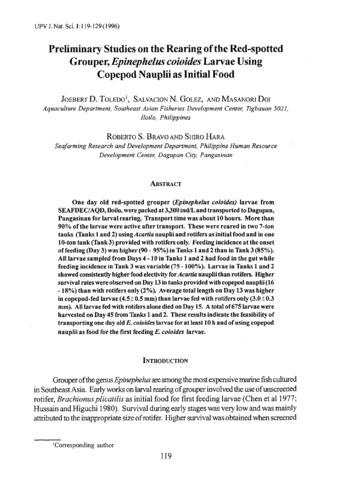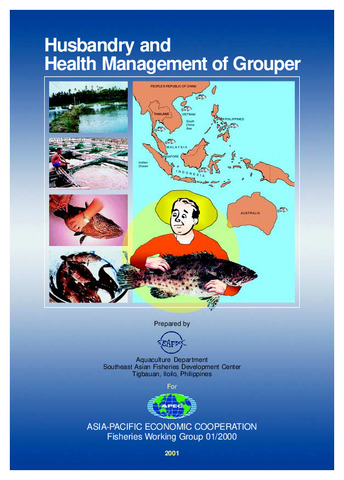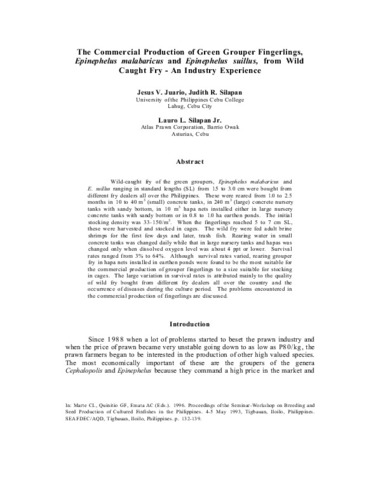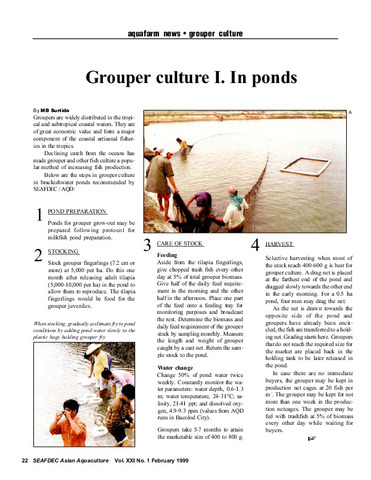Preliminary studies on the rearing of the red-spotted grouper, Epinephelus coioides larvae using copepod nauplii as initial food
Share
Abstract
One day old red-spotted grouper (Epinephelus coioides) larvae from SEAFDEC, Iloilo, were packed at 3.300 ind/L and transported to Dagupan, Pangasinan for larval rearing. Transport time was about 10 hours. More than 90% of the larvae were active after transport. These were reared in two 7-on tanks (Tanks 1 and 2) using Acartia nauplii and rotifers as a initial food and in one 10-ton tank (Tank 3) provided with rotifers only. Feeding incidence at the onset of feeding (Day 3) was higher (90-95%) in Tanks 1 and 2 than in tank 3 (85%). All larvae sampled from days 4 – 10 in Tanks 1 and 2 had food in the gut while feeding incidence in Tank 3 was variable (75-100%). Larvae in Tanks 1 and 2 showed consistently higher food electivity for Acartia nauplii than rotifers. Higher survival rates were observed in Day 13 in tanks provided with copepod nauplii (16-18%) than with the rotifers only (2%). Average total length on Day 13 was higher in copepod-fed larvae (4.5 ± 0.5 mm) than larvae fed with rotifers only (3.0 ± 0.3mm). All larvae fed with rotifers alone died on Day 15. A total of 675 larvae were harvested on Day 45 from Tanks 1 and 2. These results indicate the feasibility of transporting one day old E. coioides larvae for at least 10 h and of using copepod nauplii as food for the first feeding E. coioides larvae.
Suggested Citation
Toledo, J. D., Golez, S. N., Doi, M., Bravo, R. S., & Hara, S. (1996). Preliminary studies on the rearing of the red-spotted grouper, Epinephelus coioides larvae using copepod nauplii as initial food. UPV Journal of Natural Sciences , 1(2), 119-129. http://hdl.handle.net/10862/1574
Subject
Taxonomic term
Collections
- AQD Journal Articles [1215]
Related items
Showing items related by title, author, creator and subject.
-
Husbandry and health management of grouper
Asia-Pacific Economic Cooperation; Southeast Asian Fisheries Development Center (Asia-Pacific Economic Cooperation; Aquaculture Department, Southeast Asian Fisheries Development Center, 2001)The groupers (Family Serranidae) are among the most popular species in the live reef food fish industry in the Asia-Pacific region. Groupers are generally fast growing, hardy, suitable for intensive culture, and with ... -
The commercial production of green grouper fingerlings, Epinephelus suillus, from wild caught fry - an industry experience
Juario, Jesus V.; Silapan, Judith R.; Silapan Jr., Lauro L. (Aquaculture Department, Southeast Asian Fisheries Development Center, 1996)Wild-caught fry of the green groupers, Epinephelus malabaricus and E. suillus ranging in standard lengths (SL) from 1.5 to 3.0 cm were bought from different fry dealers all over the Philippines. These were reared from 1.0 ... -
Grouper culture
Surtida, Marilyn B. (Aquaculture Department, Southeast Asian Fisheries Development Center, 1999)






